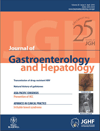Correlations among Helicobacter pylori infection and the expression of cyclooxygenase-2 and vascular endothelial growth factor in gastric mucosa with intestinal metaplasia or dysplasia
Abstract
Background and Aims: To examine the rate of Helicobacter pylori infection and the expression of cyclooxygenase-2 (COX-2) and vascular endothelial growth factor (VEGF) in gastric mucosa with intestinal metaplasia or dysplasia, and explore their correlations in precancerous gastric lesions.
Methods: A total of 172 patients were included in the study. H. pylori infection was evaluated by hematoxylin–eosin and modified Giemsa staining. The expression of COX-2 and VEGF proteins was detected by immunohistochemistry.
Results: The rates of H. pylori infection in gastric mucosal dysplasia (DYS), intestinal metaplasia in gastric mucosa (IM), chronic atrophic gastritis (CAG) and chronic superficial gastritis (CSG) patients were significant differences (P = 0.001). The average optical density (AOD) values of COX-2 staining in CSG, CAG, IM and DYS patients were 13.81 ± 5.53, 45.28 ± 21.44, 73.67 ± 26.02 and 91.23 ± 45.11, respectively, with significant differences among CSG, CAG and IM patients (P = 0.037, 0.001 and 0.047 for CSG vs CAG, CSG vs IM and CAG vs IM, respectively). The expression level of VEGF in DYS patients was significantly higher than those in other patients (P = 0.001, 0.001 and 0.001 for DYS vs CSG, DYS vs CAG and DYS vs IM, respectively). The expression levels of COX-2 in H. pylori-positive IM, CAG and DYS patients were significantly higher than those in H. pylori-negative counterparts (P = 0.043, 0.009, 0.001, respectively). Additionally, the expression level of COX-2 was positively correlated with that of VEGF with the aggravation of gastric mucosal lesions (r = 0.640, P = 0.006).
Conclusion: H. pylori infection might be able to induce the expression of COX-2 in precancerous gastric lesions, which in turn upregulates the expression of VEGF.




